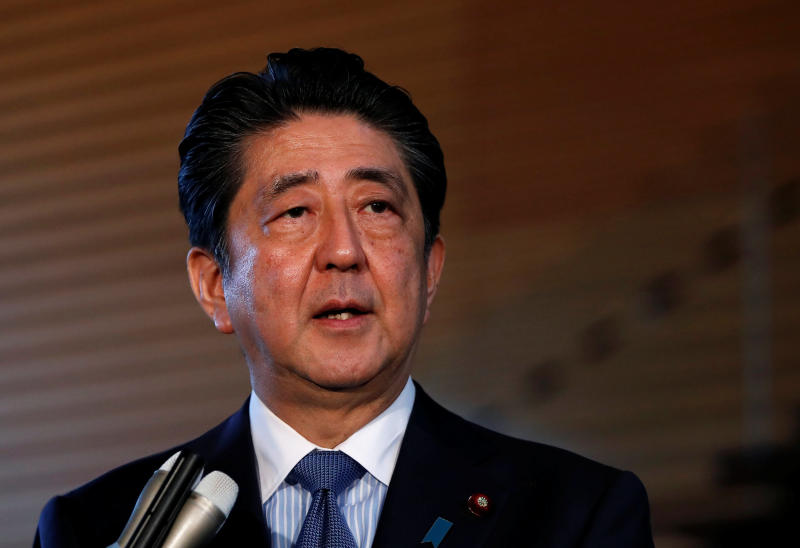Japan PM Shinzo Abe says Asia-Pacific can fly flag for free trade, amid void left by US
Sign up now: Get insights on Asia's fast-moving developments

Japanese PM Shinzo Abe urged Asia-Pacific countries to further a free, fair and rules-based economic order, at an RCEP meeting in Tokyo on July 1, 2018.
PHOTO: REUTERS
Follow topic:
TOKYO - Japanese Prime Minister Shinzo Abe, in an impassioned rallying cry for free trade, on Sunday (July 1) urged Asia-Pacific countries to take the lead to further the free, fair and rules-based economic order.
He was speaking to trade ministers of the 16-nation Regional Comprehensive Economic Partnership (RCEP) multilateral deal, who had gathered in Tokyo to iron out their differences with an eye on reaching an agreement this year.
Mr Abe pointed to how Japan's Parliament last Friday passed the Bills required to ratify the revised Trans-Pacific Partnership, now known as the TPP-11 after the US' pullout.
Japan and the European Union, which came to terms for an economic partnership agreement last year, are expected to sign the deal later this month.
Singapore's Minister for Trade and Industry Chan Chun Sing later told reporters that an ongoing review of the Republic's Economic Partnership Agreement, which came into force in 2002 in the first free trade deal for Japan, will account for issues such as e-commerce and intellectual property protection.
Mr Chan added that he was confident Singapore will be "among one of the first batches of countries to ratify the TPP-11 and I hope by the end of the year we can achieve the numbers required to bring the pact into force".
Mexico ratified the deal in April and Japan will likely do so by early this month, after it completes the necessary revisions to the relevant government ordinances.
Australia, Canada, and New Zealand have taken steps towards ratification, with Chile also aiming to do so this year. The pact will come into force 60 days after it is ratified by at least six member countries. The other parties to the deal are Brunei, Malaysia, Peru, and Vietnam.
The Nikkei Asian Review said in a report that TPP-11 trade negotiators will meet in Japan from July 17 to 19 to discuss how to let more countries into the deal, with Thailand, Indonesia, and Britain among those keen.
Mr Abe said that the RCEP was the "next in waiting", illustrating the perks that it will bring to the 3.5 billion people living in its 16 countries - which include the 10-nation Asean bloc, as well as Australia, China, India, Japan, New Zealand and South Korea. Collectively, they account for about half the world's population as well as 30 per cent of the world's economy and trade.
RCEP is not just about eliminating tariffs and boosting trade, but about drawing a "very ambitious picture for Asia's future". Setting rules for e-commerce, he said, will allow micro-businesses to thrive, such as those selling coconut oil to tourists on the streets of Yangon.
Intellectual property rules, he added, will make technology like state-of-the-art medical equipment developed in Australia more widely available - markedly improving the quality of healthcare throughout the 16 member countries.
This is particularly crucial, the trade ministers said in a tersely-worded statement, given that the current global trade environment "faces serious risks from unilateral trade actions and reactions, as well as their debilitating implications on the multilateral trading system".
Numerous countries have already taken retaliatory measures against tariffs that have been imposed by the United States.
Analysts who spoke to The Straits Times found the progress in Tokyo encouraging.
OCBC's head of treasury research and strategy Selena Ling said that while there is a tight timeline, it will be symbolically important for the RCEP to be concluded this year given the headwinds of protectionism - and also because China and Japan are the world's second and third largest economies.
DBS senior economist Irvin Seah, a former trade negotiator with Singapore's Ministry of Trade and Industry, added: "While the light of trade liberalisation has dimmed in recent years - with Brexit and anti-globalisation tendencies in the US and several parts of Europe - this should not deter Asia to continue to bear the torch."
And as questions over whether the year-end goal for RCEP is realistic, given that only two of 18 chapters have been completed, Mr Seah said that the many existing free trade agreements among Asean countries can serve as a reference to speed up the negotiations.
The issues that require political will, too, can be overcome by having "side letters", Mr Seah said, referring to how these can be carved out and set aside for further negotiation for some countries without impeding the progress of the main agreement.
National University of Singapore economist Davin Chor, in noting how all sides have been relatively discreet over their potential issues, said it suggests the desire to work towards an amicable resolution on their differences.
"This stands in contrast to the negotiations several years ago with the US over the TPP - which the US has since pulled out of - as those were more openly contentious with hot button issues being publicly surfaced," he said. "There is a sense that the countries involved in RCEP are more sensitive to the needs to accommodate each other's domestic priorities and circumstances, and to resolve any disagreements over deep integration issues such as e-commerce or intellectual property behind the scenes."

